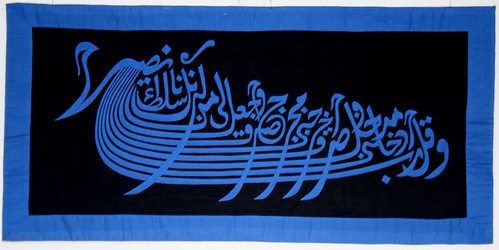Map for the Tentmakers of Cairo
Finally I can really show people how to find the Tentmakers of Old Cairo. Or how to locate Khan Khayamiya, or Kayamiya - as they are all the same thing.
My son Sam made a wonderful map for those who wish to walk. Or for those who wish to get a taxi to Either Khan El Khalili, or from Bab El Khalk (or Bab el Qalk as the pronunciation is the same). Taxis know both of those locations.
You will see Bab Zuweilah marked on the map and it looks like this.

This is the single most wonderful street to visit in Cairo to let visitors get the feel of the modern city, and of the incredible humour and kindness of Egyptians. You will not be pushed to buy and can visit, drink tea or kakadeh, and chat, and watch a wonderfully interesting world go by.
They do not make tents so much nowadays - but the work that they make now is derived from from the colourful appliquéd linings of tents of the old days, when the tentmakers (or Khayamiya in Arabic) made brilliant linings, ceilings and covered screens for the streets. They are still used:

as screens in the desert to provide essential windbreaks for cooking, eating and sleeping,

and at weddings and henna parties like this amazing one in a Cairo street.

And funerals like the one in the City of the Dead in Cairo,


and any celebration that needs to look like a celebration.

The street is beautiful. It was built in 1647 for shoemakers, but now is the domain of the men who make beautiful hand appliqué.
These are a few pieces to get you inspired.


A piece of calligraphy, from the Koran to be hung on a wall.

This is a very traditional piece here, and with traditional colours.



You can see a Flickr photoset of all of the images I took for one exhibition.
If you really feel like browsing through a LOT of photos of all sorts of things and have a few hours to spare the link to all my organised sets is here. Syria, Libya, Egypt, Tunisia, Italy and India - and lots more.
But please remember - if you know someone visiting Cairo, print off the map for them, and tell them to take a cab to:
either Khan El Khalili and start from the street opposite the green bridge on the OTHER side from the Khan,
Or
To take a cab to Bab El Khalk where you will walk up the road from the police station to Bab Zuweilah and the Tentmakers Street.
The latter is my pick as there are wonderful things to see on this street. But that is another blog.
Tell them to go without a guide. Guides demand a commission form the men for bringing tourists - and the price will go up a lot.
Say hello from me.
My son Sam made a wonderful map for those who wish to walk. Or for those who wish to get a taxi to Either Khan El Khalili, or from Bab El Khalk (or Bab el Qalk as the pronunciation is the same). Taxis know both of those locations.
You will see Bab Zuweilah marked on the map and it looks like this.

This is the single most wonderful street to visit in Cairo to let visitors get the feel of the modern city, and of the incredible humour and kindness of Egyptians. You will not be pushed to buy and can visit, drink tea or kakadeh, and chat, and watch a wonderfully interesting world go by.
They do not make tents so much nowadays - but the work that they make now is derived from from the colourful appliquéd linings of tents of the old days, when the tentmakers (or Khayamiya in Arabic) made brilliant linings, ceilings and covered screens for the streets. They are still used:

as screens in the desert to provide essential windbreaks for cooking, eating and sleeping,

and at weddings and henna parties like this amazing one in a Cairo street.

And funerals like the one in the City of the Dead in Cairo,


and any celebration that needs to look like a celebration.

The street is beautiful. It was built in 1647 for shoemakers, but now is the domain of the men who make beautiful hand appliqué.
These are a few pieces to get you inspired.


A piece of calligraphy, from the Koran to be hung on a wall.

This is a very traditional piece here, and with traditional colours.



You can see a Flickr photoset of all of the images I took for one exhibition.
If you really feel like browsing through a LOT of photos of all sorts of things and have a few hours to spare the link to all my organised sets is here. Syria, Libya, Egypt, Tunisia, Italy and India - and lots more.
But please remember - if you know someone visiting Cairo, print off the map for them, and tell them to take a cab to:
either Khan El Khalili and start from the street opposite the green bridge on the OTHER side from the Khan,
Or
To take a cab to Bab El Khalk where you will walk up the road from the police station to Bab Zuweilah and the Tentmakers Street.
The latter is my pick as there are wonderful things to see on this street. But that is another blog.
Tell them to go without a guide. Guides demand a commission form the men for bringing tourists - and the price will go up a lot.
Say hello from me.
































